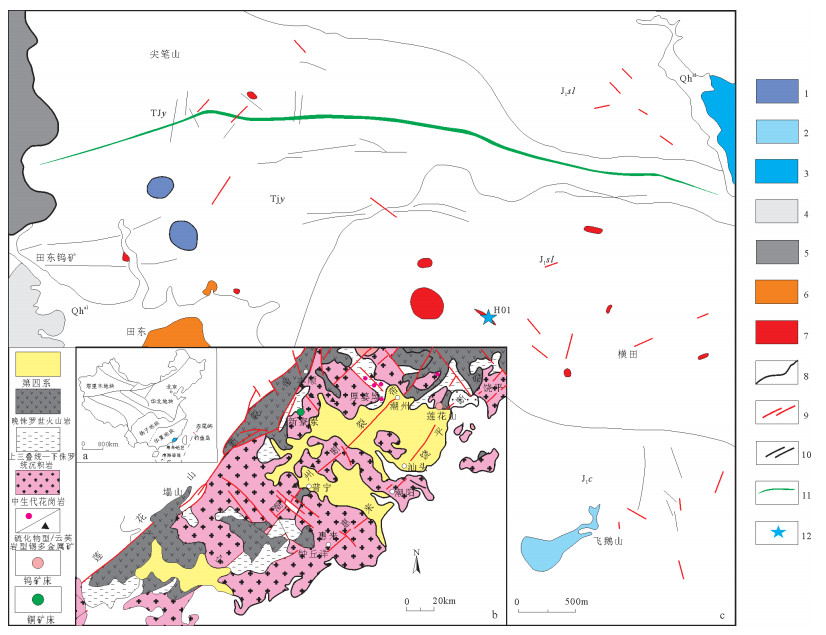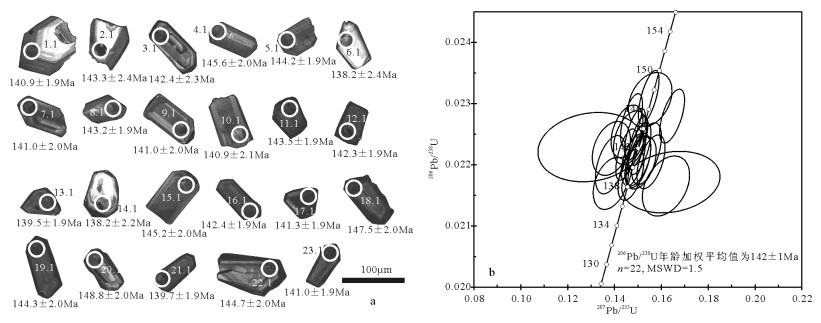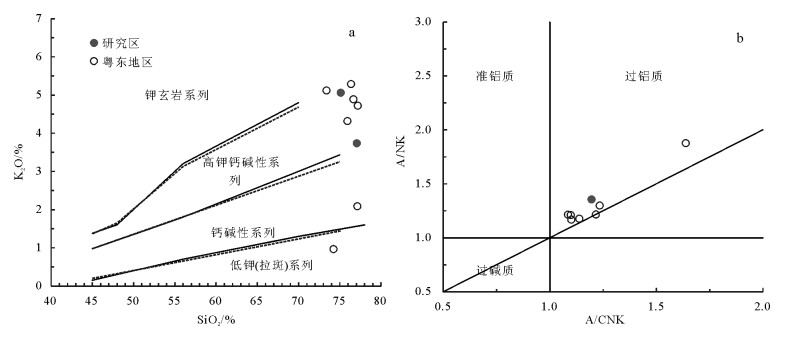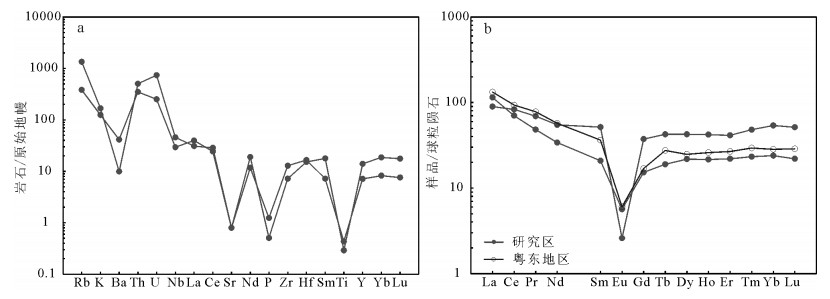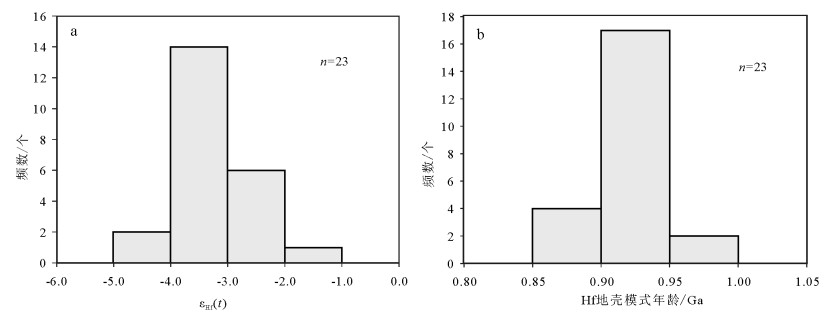SHRIMP zircon U-Pb dating, geochemistry and zircon Lu-Hf isotopic composition of Hengtian granite porphyries in eastern Guangdong Province and their geological implications
-
摘要:
横田花岗斑岩位于粤东田东钨锡多金属矿床的中部。以横田花岗斑岩为研究对象,开展了SHRIMP锆石U-Pb定年、岩石地球化学、锆石Lu-Hf同位素组成特征研究。花岗斑岩多呈岩株产出,灰白色,斑状结构,块状构造,主要由斑晶(10%)和基质(90%)组成,斑晶由斜长石、钾长石、石英、黑云母组成,杂乱分布,粒度为0.6~6mm,基质由长石、石英、黑云母组成,长石粒度为0.02~0.25mm。获得花岗斑岩锆石206Pb/238U年龄加权平均值为142±1Ma,说明岩体形成于早白垩世。主量、微量元素特征显示,花岗斑岩属于高钾钙碱性强过铝质,富集Rb、U、Nd、Hf等元素,亏损Ba、Nb、Sr、P、Ti等,与高分异的S型花岗岩相似。花岗斑岩的锆石εHf(t)值均小于0,在t-εHf(t)和t-(176Hf/177Hf)i图上,所有样品点均落在球粒陨石演化线之下和华南中元古代基底演化线之上,二阶段模式年龄变化范围为1.28~1.47Ga,表明成岩物质主要来源于中元古代古老地壳变质泥岩部分熔融。
Abstract:The granite porphyry related to tungsten-tin polymetallic deposits was discovered in Hengtian area, eastern Guangdong Province. In this paper, the authors reported detailed studies of SHRIMP zircon U-Pb dating, major elements, trace elements and zircon Hf isotopic compositions of the granite porphyry. The granite porphyries are mostly grayish white dykes with porphyritic texture and massive structure. They mainly consist of phenocrysts (10%) and matrix (90%), the phenocrysts are composed of plagioclase, Kfeldspar, quartz and biotite with particle size of 0.6~6mm in mixed and disorderly distribution, whereas the matrix is composed of feldspar, quartz and biotite, with the feldspar particle size being generally 0.02~0.25mm. Zircon U-Pb age analysis for the granite porphyry yielded a weighted average 206Pb/238U age of 142±1Ma, indicating that the rock was formed in Early Cretaceous. Major and trace element characteristics show that the granite porphyry belongs to high potassium calc-alkaline peraluminous series en-riched in Rb, U, Nd, HF and depleted in Ba, Nb, Sr, P, Ti, similar to features of highly fractionated S-type granites. The εHf(t) values of the granite porphyry are less than 0; in t-εHf(t) and t-(176Hf/177Hf)i diagrams, all points fall under the chondritic evolu-tion line and above the south of the Mesoproterozoic basement evolution line. Moreover, the ages are between 1.28Ga and 1.47Ga, indicating that rock-forming materials were mainly derived from the partial melting of metamorphic mudstone in Meso-proterozoic ancient crust.
-
柴达木盆地为青藏高原北缘最大的山间盆地[1-2],随着高原的隆升,自新生代以来沉积了周缘造山带剥落的巨厚碎屑沉积物。长期以来,学者们对青藏高原的研究多围绕东部、南部和高原内部区域进行,关于其隆升历史的认识主要来自地层沉积速率变化和Ar-Ar定年、裂变径迹低温热年代学方法,对盆地尤其是柴达木盆地新生代沉积物与高原和毗邻山脉的制约关系涉及较少[3-5]。沉积物作为连接盆地和剥蚀源区的纽带,准确记录了印度和欧亚板块碰撞过程中周缘造山带的构造活动及隆升过程[6-9]。另一方面,沉积物在搬运、堆积过程中,成分受环境和气候影响小,且不受地域构造热事件的约束,可以作为洞悉盆山耦合过程及相互作用的理想载体。对柴达木盆地沉积物源追踪及特征的研究,是反演和认识高原北缘构造隆升历程的有效途径,有助于解决整个青藏高原的隆升问题。
本文以柴达木盆地北缘露头较好、年代精确、新生代地层连续的路乐河地区沉积剖面为研究对象,应用阴极发光技术,通过标志性碎屑组分变化的对比和系统的物源分析,识别路乐河地区对周缘造山带的响应沉积,有效界定青藏高原北缘构造运动和隆升事件的时限,为进一步科学认识高原演化、隆升历史及板块碰撞远程效应提供重要线索。
1. 地质概况
路乐河地区位于柴达木盆地的北缘,在大地构造位置上,东北毗邻祁连山-南山,西北靠近赛北逆冲断裂[10]和略远的阿尔金左行走滑断裂带[11-12],南端远离东昆仑山脉(图 1-a)。受南特提斯洋盆的俯冲消减及印度-欧亚碰撞远程效应的影响,柴达木盆地及邻接造山带经历了多期次的重大构造地质事件[13-17]。路乐河地区也沉积了巨厚的新生代岩层,记录着盆地接纳沉积物填充过程中山脉隆升与环境变化的演化信息,能够为研究青藏高原北缘造山带的隆升增添佐证。路乐河地区地层从底到顶依次为白垩系犬牙沟组(K1q)、古新统—始新统路乐河组(E1+2l)、始新统下干柴沟组(E2g)、渐新统上干柴沟组(E3g)、中新统下油砂山组(N1y1)和上油砂山组(N1y2),以及中新统—上新统狮子沟组(N1+2s)共7套地层(图 1-b)[18]。其中路乐河组与犬牙沟组呈角度不整合接触,下、上油砂山组界线不明显,文中并称为油砂山组。
据马海幅1:20万区域地质调查报告①,赛什腾山主要岩性有浅变质千枚岩和绢云母片岩、碎屑岩及大量花岗岩类,并含少量安山岩、玄武岩等中基性喷出岩。南祁连山以古元古界片麻岩和大理岩深变质岩系、石炭系和三叠系碎屑岩、碳酸盐岩及达肯大坂地区达肯大坂群的斜长片麻岩和变质石英岩为主,出露岩浆岩主要为加里东期和海西期花岗岩、奥陶纪和志留纪中酸性火山岩。阿尔金山脉主要出露中、新元古界及少量奥陶系[19-20],中元古界岩性为变质碎屑岩、碳酸盐岩,发育少量玄武岩-安山岩-流纹岩组合,蓟县系出露些许闪长岩、花岗岩等侵入岩;新元古界和奥陶系均由碎屑岩和碳酸盐岩组成,火山岩不发育;新元古界变质岩系分布较多,由变质砂岩、斜长变粒岩、角闪片岩及结晶灰岩构成。
2. 碎屑矿物阴极发光特征
2.1 阴极发光原理
在外部能量的激发下,多数绝缘矿物会发生光子辐射。当激发源为高能电子束时,矿物发射可见光波段的光子,即为阴极发光(Cathodolumines-cence)[21]。矿物阴极发光根本上是由晶格中的微量元素或固有缺陷激发引起的,这些元素和晶格缺陷统称为发光中心(Luminescence centers)[22]。晶格中发光中心含量越高、越密集,矿物阴极发光的强度越强[23]。碎屑岩中不同类型的矿物颗粒,像石英、长石等,以及不同成因的矿物晶体,如喷出型石英和侵入型石英,由于其内部结构、元素组成各不相同,其阴极发光的颜色和强度也有所差别,因此阴极发光可以很好地指示沉积岩碎屑成分,这已为多数学者认同[24-29]。
2.2 阴极发光特征
石英是碎屑岩中含量最高的造岩矿物,传统的碎屑组分统计方法将其简单地划分为单晶石英和多晶石英,忽略了石英不同成因及来源的深层次信息。一般而言,蓝紫色、深蓝色-蓝色为岩浆岩石英,棕色、深棕褐色阴极光为变质型来源(图版Ⅰ-A、B)。由于石英重结晶过程中微量元素和晶格缺陷重新调整,或变形强烈造成高密度的发光中心,能量激发时声子发射(能量热)代替光子发射,从而降低了发光强度[30-31]。长石也是碎屑岩中常见的造岩矿物,在长距离搬运过程中易发生破裂、溶解,故长石含量的高低可以作为岩石风化强度和搬运距离的量化指标。如图版Ⅰ-B、C所示,斜长石阴极发光显示天蓝色、灰蓝色、黄绿色和少量黄色,微斜长石发黄灰色阴极光,其中亮蓝色为碱性长石(钙长石、钾长石),钙长石因Fe2+的存在呈芥末黄色、灰蓝色,酸性更长石以黄绿色居多[24, 32-33]。
![]() 图版ⅠA.岩浆型石英(Q1)、变质型石英(Q2)阴极发光特征;B.碳酸盐岩(Lsc)阴极发光特征;C.不同类型长石(K为微斜长石,P为长石)阴极发光特征;D.泥岩(Ls)阴极发光特征;E.变质石英岩(Lm)及碳酸盐胶结世代(C1、2)阴极发光特征;F.千枚岩-片岩(Lm)、花岗岩(Lg)阴极发光特征;G.喷出岩(Lv)阴极发光特征(图片据参考文献[36]);H.路乐河砂岩砾石组分特征图版Ⅰ.
图版ⅠA.岩浆型石英(Q1)、变质型石英(Q2)阴极发光特征;B.碳酸盐岩(Lsc)阴极发光特征;C.不同类型长石(K为微斜长石,P为长石)阴极发光特征;D.泥岩(Ls)阴极发光特征;E.变质石英岩(Lm)及碳酸盐胶结世代(C1、2)阴极发光特征;F.千枚岩-片岩(Lm)、花岗岩(Lg)阴极发光特征;G.喷出岩(Lv)阴极发光特征(图片据参考文献[36]);H.路乐河砂岩砾石组分特征图版Ⅰ.岩屑是母岩机械破碎的产物,继承了母岩岩性和岩石的结构特征,可直接反映物源区的岩石类型及岩性组合[34-35]。常见的岩屑类型有沉积岩、变质岩和岩浆岩。沉积岩岩屑含泥岩、碳酸盐岩等;泥岩岩屑不具阴极发光,但内部显示大量无规则的蓝色石英斑点(图版Ⅰ-D),识别标志独特,碳酸盐岩阴极发光颜色主要为亮黄色和橙红色色调,且可观察到碎屑颗粒至少经历了2期世代的碳酸盐胶结作用(图版Ⅰ-B、E)。路乐河碎屑组分变质岩岩屑含量较高,主要为千枚岩-片岩和石英岩。千枚岩-片岩岩屑与泥岩相似,表面含蓝色和棕色阴极光斑点,但其微定向排列的特点及规则外形易于被甄别(图版Ⅰ-A、F)。石英岩由砂岩和硅质岩经区域变质或接触变质作用形成,由多个亚石英晶粒构成,颗粒之间呈镶嵌接触,阴极发光呈棕色和部分蓝色(图版Ⅰ-E),前者表示其经历了高级变质重结晶作用[26]。侵入岩岩屑以花岗岩岩屑最常见,阴极发光下,花岗岩岩屑亦可见典型的花岗结构(图版Ⅰ-A、F),矿物颗粒明显;酸性喷出岩基质阴极发光呈血红色,石英斑晶不发光,两者界线截然(图版Ⅰ-G)。
3. 分析结果及物源指示
盆地沉积物主要由周缘造山带基岩经抬升剥蚀、搬运堆积形成,碎屑成分变化可以间接反映母岩或物源区的改变[37]。另外,沉积序列中特征岩石组分的出现标志着毗邻造山带隆升活动的启动[38-39]。依据上述不同矿物及岩屑类型的阴极发光特征,共完成了50件碎屑岩薄片组分的统计。统计工作在中国石油华北油田勘探开发研究院生油实验室完成,样品分布于各个层组,并对特征矿物和岩屑含量垂向序列变化进行了比较。
3.1 碎屑组分变化
沉积碎屑组分变化是反映盆地物源演化历程的重要物质表现。值得注意的是,单种碎屑成分的突然出现或消失,可以解释为构造运动造成源区物质组成的改变,再者出露地层被剥蚀殆尽所致。通过对比发现(图 2),新生代53.5~2.9Ma期间,路乐河沉积碎屑组分垂向上有3次明显的阶段性波动。第一次急剧变化发生在路乐河组中部,时间为50.1~46.6Ma,石英、长石及火山岩岩屑含量均保持在最低水平,石英岩岩屑达到峰值。盆地沉积物的高速率堆积与高原造山带的隆升相对应[41],暗示路乐河源区山脉经历了相对短暂的快速隆升剥蚀事件。在路乐河组与下干柴沟组交界(约44.5Ma),以云母和黄绿色长石首次大量出现及火山岩岩屑消失为标志,为路乐河地区沉积物源的第二次转换事件,碳酸盐岩和变质岩岩屑含量也急剧降低。云母主要赋存于花岗岩类或低级变质岩中,故云母的出现表征了物源区上述岩石的大面积暴露。第三次显著变化位于上干柴沟组顶部,时间为22.6Ma左右,黄绿色长石、碳酸盐岩和变质岩岩屑突增,变质型石英也呈增加趋势。概略地说,在50.1~46.6Ma、44.5Ma和22.6Ma前后,路乐河物源区可能爆发了剧烈的构造活动,致使路乐河地区沉积物组分发生阶段性变化。
![]() 图 2 路乐河地区物源转换事件与全球气候变化图(δ18O据参考文献[40])Figure 2. Transformation events in Lulehe and global climatic changes during the Cenezoic period
图 2 路乐河地区物源转换事件与全球气候变化图(δ18O据参考文献[40])Figure 2. Transformation events in Lulehe and global climatic changes during the Cenezoic period3.2 物源分析
河流是沉积物搬运的主要载体,古水流流向或优势流向的识别,有助于判别物源方位、追溯源区[42]。自古新世以来,柴达木盆地一直是一个内流汇水盆地[43-44],古水系[10]和物源恢复显示(图 3),路乐河地区新生代水流方向变化稳定,主体方位为SW向。此外,在路乐河地区除50.1~46.6Ma整个新生代沉积期外,碎屑矿物长石含量较高,平均为24.3%,其母岩类型应以含长石丰富的花岗岩或花岗片麻岩类为主[45-46],这同野外见到大量花岗岩及片麻岩砾石成分的事实一致(图版Ⅰ-H)。高长石含量的特征反映碎屑岩成分成熟度低,地层为干旱气候条件近物源快速搬运堆积形成。结合古水流方向和沉积物源方向可知(图 3),路乐河沉积体系主要受NE向南祁连和赛什腾造山带的供给制约,其沉积碎屑组分的3次变化分别表征物源的3次转变事件。
![]() 图 3 柴达木盆地新生代物源及古水流变化②Figure 3. The change of provenance and paleocurrent in Qaidam basin during the Cenozoic period
图 3 柴达木盆地新生代物源及古水流变化②Figure 3. The change of provenance and paleocurrent in Qaidam basin during the Cenozoic period(1)从犬牙沟组顶部到50.1Ma,各造岩矿物(长石、石英)及岩屑组分(石英岩、火山岩等)稳定沉积。通过对比赛什腾和南祁连山的岩性发现,变质石英岩、酸性火山岩和碳酸盐岩仅在南祁连山发育,因此路乐河此阶段物源区主要为南祁连山。50.1~46.6Ma,石英岩含量急增,表明南祁连可能经历过加速隆升事件[41],隆升引起变质岩基高速剥蚀,进而石英岩岩屑含量增大,其余组分则大幅减少。46.6Ma之后,碎屑组分恢复至50.1Ma之前的状态,南祁连山构造趋于稳定。
(2)44.5Ma,云母的发育表征了花岗岩类或含云母低级变质岩的大面积暴露,这与赛什腾山岩性一致,表明南祁连山不再是路乐河物源的主要供给者;另一方面,酸性火山岩岩屑的消失也指示路乐河的主要物源区由南祁连山向赛什腾山转变,石英岩和碳酸盐岩岩屑含量逐渐减少至消失亦印证了这一观点。
(3)22.6Ma前后,路乐河物源区再次发生转变。云母的稳定沉积及千枚岩-片岩的出现,反映赛什腾山持续为路乐河供给物源,而石英岩和碳酸盐岩岩屑的重新发育,表明南祁连山也开始为路乐河地区提供大量碎屑物质。变质岩贡献比例的加强,使岩浆型和变质型石英分别呈缩减和增加趋势。
4. 物源转换对构造隆升的响应
造山带的隆升和盆地的沉积是一个耦合过程,气候变化和构造运动对青藏高原隆升均具有一定的影响,如构造隆升促进化学风化作用的增加[47-48],造成大量基岩的脱落和搬运堆积;气候异常引起的快速侵蚀卸载作用造成山体总质量的亏缺,进而发生重力均衡效应[49],迫使山体抬升。但在长时间和大空间尺度上,构造运动对地体抬升的制约更甚于气候变化的影响[50-53],且构造活动的强弱程度能够由山脉剥蚀量或物源区岩性的变化直接体现[54]。与此同时,始新世早—中期和中新世早期全球气候变化趋于稳定(图 2),因此气候条件对路乐河地区新生代物源变化的影响可不予考虑。
(1)50.1~46.6Ma构造隆升响应
早在65~55Ma,印度和欧亚板块就已发生拼贴碰撞[12, 55-57],并在55~45Ma达到高峰[58],陆内拉萨、羌塘等刚性块体远程传递两大板块汇聚的强劲应力,隆升活动也同步传达到了高原北部地区[59-61]。现有柴达木和河西走廊地层学资料显示,阿尔金断裂起始于古新世49Ma[12],柴盆北缘的赛北断裂带及柴北缘断裂带在54.8~49Ma开始形成[10]。Jo-livet等[62]通过片麻岩磷灰石热模拟研究发现,祁连山在50Ma左右发生了快速的剥露事件,在路乐河剖面也曾报道51Ma存在一期高速率沉积[63]。从更大空间尺度看,青藏高原早期阶段的隆升在其他地区也有响应,如距高原较远的西南天山托云盆地新生代48.1±1.6Ma的幔源岩浆活动[64-65]和白垩纪—古近纪期间的托云块体旋转运动[66],可见青藏高原北缘构造变形活动相比印度-欧亚板块碰撞,滞后了约10±5Ma。以上研究均与南祁连山开始为路乐河地区提供大量剥蚀物的时限一致,揭示南祁连山50.1~46.6Ma的急剧抬升是对印度-欧亚板块碰撞的远程响应,也是碰撞应力在高原北部远程传递的有力证据。
(2)44.5Ma构造隆升响应
此时,印度与欧亚板块已完成全面碰撞,汇聚产生的应力推挤陆内已拼合的块体,使之横向缩短并相互叠置,引起陆内严重形变和逆冲推覆构造[67-68]。经热年代学研究[69],在当雄地区新厘定的纳木错逆冲推覆构造于古近纪44Ma经历过一次变形抬升事件,在高原腹地不同位置还发现大规模挤压型钾质-超钾质火山岩的踪迹[70-73],且在45~40Ma岩浆活动异常活跃。岩浆是板块碰撞挤压最直观的表现,区域性的岩浆侵位必将造成岩石圈增厚,高原整体性抬升[68, 74-75],在羌塘多格错仁地区新发现的埃达克岩表明,地壳在45~38Ma经历了缩短加厚[76]。然而,古地磁数据揭示[77],中始新世—早渐新世阿尔金主断裂和柴北缘断裂带山前沉积未发生明显的旋转变形,换言之,青藏高原新生代第二阶段的隆升以地壳垂向增生为主,具体表现为陆内块体南北向缩短、岩浆侵位和块体边界逆冲构造的发育。从44.5Ma开始,路乐河物源区由南祁连山向赛什腾山快速转变,表明赛北逆冲断裂伴随显著的隆升卸载作用,对应于高原内部的构造隆升事件。
(3)22.6Ma构造隆升响应
印度板块在中新世持续向大陆俯冲,逆冲构造以前展式推覆方式向前陆迁移、消减,形成一系列走滑-逆冲断裂和地层形变[67, 78]。来自五道梁雅西措组的古地磁结果显示,可可西里盆地在渐新世末期有29.1°±8.5°的顺时针垂轴旋转[79],赛北断裂山前地层有14°左右的移位[78]。George等[80]基于酒西盆地磷灰石裂变径迹分析,揭示出祁连山23Ma的快速隆升事件,Wang等[81]也获得了相同的冷却年龄。同时,西秦岭发生与高原隆升响应的构造-热事件,剥蚀速率急增[82],此次运动得到岩浆活动(22~23Ma)的证实[83-84],在高原内部也广泛存在相近年龄的火山喷发活动[85-89]。另一方面,在东昆仑山和阿尔金山前盆地也保留了中新世22Ma前后的岩浆活动、磨拉石沉积、断层平移、物源转型等隆升事件的地质记录[43, 62, 90-92],遥远的喀拉昆仑和西天山地区[93]亦发生与印度-欧亚板块碰撞相关的山体快速剥露事件。不言而喻,青藏高原在渐新世—中新世之交发生了大规模的构造运动,几乎波及整个高原。青藏高原整体性准同时隆升,进一步肯定了22.6Ma南祁连山与赛什腾山协同为路乐河供应沉积物的合理性。路乐河地区物源3次阶段性变化的认识也间接反映了青藏高原为阶段式隆升的观点[13, 67, 94-95]。
5. 结论
(1)沉积碎屑组分变化是反映盆地物源演化过程的重要物质表现。路乐河地区新生代碎屑组分高长石含量的特点,指示其为近物源搬运沉积形成。同时沉积物来源方向和周缘山系岩性对比揭示,路乐河物源主要受南祁连山和赛什腾山供给的控制。
(2)路乐河地区物源在新生代53.5~2.9Ma期间至少存在3次转换,发生时间同印度-欧亚板块碰撞及高原构造隆升事件吻合,间接反映了青藏高原为阶段式隆升的观点,时间依次为50.1~46.6Ma、44.5Ma和22.6Ma,深入认识青藏高原隆升历史及板块碰撞远程效应具有重要意义。
(3)44.5Ma之前,路乐河物源区主要为南祁连山,而50.1~46.6Ma南祁连山的快速抬升是对印度-欧亚板块初始碰撞应力的传递响应;青藏高原第二阶段的隆升以地壳垂向增厚为主,逆冲推覆构造发育,赛北断裂于44.5Ma发生显著的剥露作用,路乐河物源区由南祁连向赛什腾山转变;渐新世—中新世之交(22.6Ma),青藏高原准同时整体性隆升,赛什腾山和南祁连山协同为路乐河地区供应沉积物。
致谢: 野外调查研究期间得到广东省第二地质大队原队长刘石华、谢色新总工程师及广东省地质调查院同仁的帮助,北京离子探针中心的刘建辉老师指导锆石测年实验和完成了数据处理,岩石地球化学判别图使用路远发教授开发的Geokit软件,审稿专家对本文提出诸多宝贵的意见和建议,在此一并表示衷心的感谢。 -
图 5 花岗斑岩原始地幔标准化微量元素蛛网图(a)和球粒陨石标准化稀土元素配分图(b)(标准化值据参考文献[50])
Figure 5. Primitive mantle-normalized trace element patterns (a) and chondrite-normalized REE patterns (b) of granite porphyry
表 1 花岗斑岩SHRIMP锆石U-Pb同位素测试分析结果
Table 1 SHRIMP zircon U-Pb data of granite porphyry
测试点 U/10-6 Th/10-6 Th/U 206Pb*/% 206Pbc/% 207Pb*/206Pb* ±% 207Pb*/235U ±% 206Pb*/238U ±% 206Pb/238U 年龄/Ma H01-1.1 652 235 0.37 12.3 -- 0.04960 2.1 0.1511 2.4 0.02210 1.3 140.9 ±1.9 H01-2.1 143 45 0.32 2.78 1.23 0.04870 4.6 0.1510 4.9 0.02247 1.6 143.3 ±2.4 H01-3.1 700 338 0.50 13.4 0.10 0.05570 1.9 0.1714 2.4 0.02233 1.5 142.4 ±2.3 H01-4.1 1081 511 0.49 21.1 0.00 0.05101 1.5 0.1606 2.0 0.02284 1.3 145.6 ±2.0 H01-5.1 1279 617 0.50 24.8 0.06 0.04960 2.3 0.1546 2.6 0.02263 1.3 144.2 ±1.9 H01-6.1 285 196 0.71 5.30 -- 0.05510 3.0 0.1647 3.3 0.02167 1.5 138.2 ±2.4 H01-7.1 947 408 0.45 17.9 0.12 0.05263 1.7 0.1605 2.1 0.02211 1.3 141.0 ±1.9 H01-8.1 694 219 0.33 13.3 0.48 0.05220 1.9 0.1616 2.3 0.02246 1.3 143.2 ±1.9 H01-9.1 607 300 0.51 11.5 -- 0.05350 2.1 0.1630 2.4 0.02211 1.3 141.0 ±2.0 H01-10.1 895 333 0.38 17.0 0.37 0.04923 1.8 0.1500 2.3 0.02210 1.4 140.9 ±2.1 H01-11.1 1797 956 0.55 34.5 -- 0.05335 1.2 0.1656 1.7 0.02251 1.2 143.5 ±1.9 H01-12.1 1466 702 0.50 27.9 0.05 0.05334 1.3 0.1642 1.8 0.02233 1.3 142.3 ±1.9 H01-13.1 876 354 0.42 16.4 0.45 0.05282 1.8 0.1593 2.2 0.02187 1.3 139.5 ±1.9 H01-14.1 304 164 0.56 5.65 -- 0.05330 3.3 0.1592 3.6 0.02168 1.4 138.2 ±2.2 H01-15.1 943 408 0.45 18.4 -- 0.05193 1.7 0.1631 2.1 0.02278 1.3 145.2 ±2.0 H01-16.1 1168 538 0.48 22.3 -- 0.05153 1.6 0.1587 2.0 0.02234 1.3 142.4 ±1.9 H01-17.1 1687 777 0.48 32.0 -- 0.05179 1.3 0.1582 1.8 0.02216 1.2 141.3 ±1.9 H01-18.1 1588 881 0.57 31.5 -- 0.05007 1.3 0.1598 1.8 0.02315 1.2 147.5 ±2.0 H01-19.1 1118 507 0.47 21.6 0.26 0.05452 1.4 0.1702 1.9 0.02264 1.3 144.3 ±2.0 H01-20.1 1012 445 0.45 20.1 0.38 0.05900 2.3 0.1900 2.6 0.02336 1.3 148.8 ±2.0 H01-21.1 1027 434 0.44 19.3 0.11 0.05120 1.7 0.1547 2.1 0.02191 1.3 139.7 ±1.9 H01-22.1 1465 1068 0.75 28.3 0.03 0.05503 1.2 0.1722 1.8 0.02270 1.2 144.7 ±2.0 H01-23.1 1102 551 0.52 20.9 -- 0.05201 1.8 0.1586 2.2 0.02212 1.3 141.0 ±1.9 注:Pbc和Pb*分别代表普通铅和放射铅 表 2 花岗斑岩主量、微量和稀土元素分析结果
Table 2 Major, trace and rare earth element compositions of granite porphyry
序号 1 2 3 4 5 6 7 8 9 SiO2 77.06 75.12 75.93 76.66 77.18 73.38 76.37 74.24 77.12 TiO2 0.094 0.063 0.186 0.07 0.07 0.19 0 0.05 0.08 Al2O3 13.07 12.78 12.49 12.62 12.41 13.27 12.71 15.31 13.22 Fe2O3 2.75 0.42 0.82 0.88 0.72 1.06 0.49 0.41 0.46 FeO 0.4 1.55 0.66 1.19 0.71 1.54 1.23 0.41 2.1 MnO 0.0065 0.065 0.08 0.03 0.07 0.03 0.03 0.04 MgO 0.14 0.057 0.3 0.15 0.11 0.28 0.13 0.13 0.86 CaO 0.094 0.7 0.59 0.01 0.21 0.73 0.29 0.45 0.57 Na2O 0.26 2.39 3.42 3.08 3.29 3.26 2.46 7.32 2.90 K2O 3.74 5.06 4.32 4.89 4.72 5.12 5.29 0.97 2.09 P2O5 0.027 0.011 0.03 0.01 0.01 0.06 0.15 0.06 灼失 2.27 1.34 0.56 0.59 1.11 1.03 总计 99.90 99.56 98.77 98.05 100.05 99.90 分异指数(DI) 86.19 90.88 92.17 94.43 95.28 90.99 93.15 95.18 85.68 液相线温度 682 728 720 720 708 771 716 762 709 H2O含量 5.16 4.63 4.72 4.73 4.86 4.15 4.77 4.25 4.84 A/CNK 2.813 1.196 1.098 1.216 1.138 1.085 1.234 1.101 1.638 A/NK 2.913 1.356 1.211 1.217 1.178 1.215 1.299 1.169 1.878 SI 1.97 0.6 3.16 1.47 1.15 2.49 1.35 1.41 10.23 AR 1.87 2.1 3.19 2.9 3.18 2.74 2.22 3.22 2.13 A/MF 2.95 4.44 4.55 3.95 5.63 3.12 4.71 10.67 2.3 C/MF 0.04 0.44 0.39 0.01 0.17 0.31 0.2 0.57 0.18 Li 16.10 94.50 7.05(4) Be 4.99 4.27 4.44(4) Sc 4.22 3.26 V 0.67 1.38 2.59(4) Cr 6.12 7.53 53.39(4) Co 221.00 565.00 1.19(4) Ni 5.60 20.30 3.72(4) Cu 7.26 5.84 11.75(4) Zn 11.30 38.50 15.74(4) Ga 19.90 19.60 Ge 1.41 1.74 As 166.00 1.81 0.91(4) Rb 243.10 855.40 204 Sr 16.72 16.83 64 Zr 144.00 80.50 73 Nb 20.90 32.45 9.52(4) Cs 4.81 8.96 6.8(4) Ba 289.38 69.32 160.55(4) Hf 5.12 4.71 5.9 Ta 3.18 6.62 3.5(4) W 503 1140 4.29(4) 5 Tl 1.34 1.52 Pb 25.4 12 46.83(4) Bi 15.4 1.36 0.3(4) Th 29.65 42.81 U 5.28 15.51 Mo 2.27 0.465 4.09(4) Ag 0.377 0.504 Cd 1.17 1.11 0.15(4) In 0.411 0.299 Sn 26.8 19.8 1.2(4) 86 100 Sb 0.259 0.0482 0.15(4) La 27.18 21.20 31.41 Ce 43.06 50.89 57.18 Pr 4.58 6.56 7.41 Nd 15.85 25.59 26.65 Sm 3.19 7.90 5.56 Eu 0.33 0.15 0.35 Gd 3.13 7.69 3.47 Tb 0.71 1.59 1.03 Dy 5.53 10.81 6.29 Ho 1.22 2.38 1.47 Er 3.64 6.84 4.43 Tm 0.59 1.23 0.75 Yb 4.06 9.16 4.83 Lu 0.56 1.30 0.73 Y 32.30 63.30 44.14 ΣREE 153.29 113.63 151.56 LREE 112.28 94.18 128.56 HREE 41.00 19.44 23.00 LREE/HREE 2.74 4.84 5.59 (La/Yb)N 1.66 4.80 4.66 δEu 0.06 0.31 0.23 δCe 1.05 0.86 0.89 资料来源 本文 本文 ③ ④ ④ ④ [43] [44] [45] 注:(4)表示括号内样品件数;主量元素含量单位为%,稀土和微量元素为10-6 表 3 花岗斑岩Lu-Hf同位素分析结果
Table 3 Zircon Lu-Hf isotopic composit ions of granite porphyry
测点编号(原锆石点号) t/Ma 176Yb/177Hf 176Lu/177Hf 176Hf/177Hf 2σ (176Hf/177Hf)i εHf(t) TDM1/Ga TDM2 ƒLu-Hf H01-1(23.1) 141.0 0.0397 0.0014 0.282596 0.000023 0.282592 -3.69 0.94 1.40 -0.96 H01-2(22.1) 144.7 0.0376 0.0013 0.282618 0.000022 0.282614 -2.82 0.91 1.35 -0.96 H01-3(21.1) 139.7 0.0454 0.0016 0.282611 0.000027 0.282607 -3.20 0.92 1.37 -0.95 H01-4(20.1) 148.8 0.0250 0.0009 0.282592 0.000025 0.282589 -3.62 0.93 1.41 -0.97 H01-5(19.1) 144.3 0.0401 0.0014 0.282596 0.000018 0.282592 -3.62 0.94 1.40 -0.96 H01-6(18.1) 147.5 0.0397 0.0015 0.282566 0.000025 0.282562 -4.61 0.98 1.47 -0.96 H01-7(17.1) 141.3 0.0489 0.0018 0.282616 0.000018 0.282611 -3.01 0.92 1.36 -0.95 H01-8(16.1) 142.4 0.0362 0.0013 0.282610 0.000019 0.282606 -3.15 0.92 1.37 -0.96 H01-9(15.1) 145.2 0.0406 0.0015 0.282597 0.000024 0.282593 -3.57 0.94 1.40 -0.95 H01-10(14.1) 138.2 0.0310 0.0012 0.282589 0.000024 0.282586 -3.97 0.94 1.42 -0.97 H01-11(13.1) 139.5 0.0303 0.0011 0.282618 0.000024 0.282615 -2.91 0.90 1.35 -0.97 H01-12(12.1) 142.3 0.0453 0.0017 0.282634 0.000026 0.282630 -2.34 0.89 1.32 -0.95 H01-13(11.1) 143.5 0.0344 0.0013 0.282592 0.000025 0.282589 -3.76 0.94 1.41 -0.96 H01-14(10.1) 140.9 0.0352 0.0013 0.282600 0.000022 0.282597 -3.54 0.93 1.39 -0.96 H01-15(9.1) 141.0 0.0418 0.0015 0.282598 0.000024 0.282594 -3.63 0.94 1.40 -0.95 H01-16(8.1) 143.2 0.0271 0.0010 0.282589 0.000019 0.282586 -3.85 0.94 1.42 -0.97 H01-17(7.1) 141.0 0.0394 0.0014 0.282650 0.000021 0.282646 -1.78 0.86 1.28 -0.96 H01-18(6.1) 138.2 0.0444 0.0016 0.282640 0.000024 0.282636 -2.21 0.88 1.31 -0.95 H01-19(5.1) 144.2 0.0421 0.0015 0.282599 0.000020 0.282595 -3.52 0.94 1.40 -0.95 H01-20(4.1) 145.6 0.0313 0.0011 0.282583 0.000023 0.282580 -4.02 0.95 1.43 -0.97 H01-21(3.1) 142.4 0.0356 0.0013 0.282617 0.000020 0.282614 -2.90 0.91 1.36 -0.96 H01-22(2.1) 143.3 0.0131 0.0005 0.282632 0.000017 0.282631 -2.28 0.87 1.32 -0.99 H01-23(1.1) 140.9 0.0281 0.0010 0.282589 0.000020 0.282586 -3.90 0.94 1.42 -0.97 -
徐晓春, 岳书仓.粤东地区中生代火山岩与侵入岩的成因关系及成因类型[J].合肥工业大学学报(自然科学版), 1994, 4:184-192. http://www.cnki.com.cn/Article/CJFDTOTAL-HEFE404.031.htm 徐晓春, 岳书仓.粤东地区中生代岩浆作用的大地构造背景及构造-岩浆演化[J].合肥工业大学学报(自然科学版), 1996, 1:127-134. http://www.cnki.com.cn/Article/CJFDTOTAL-HEFE601.022.htm 周新民.南岭地区晚中生代花岗岩成因与岩石圈动力学演化[M].北京:科学出版社, 2007:1-691. 李献华, 李武显, 李正祥.再论南岭燕山早期花岗岩的成因类型与构造意义[J].科学通报, 2007, 52(9):981-991. http://www.cnki.com.cn/Article/CJFDTOTAL-KXTB200709000.htm 毛景文, 谢桂青, 郭春丽, 等.南岭地区大规模钨锡多金属成矿作用:成矿时限及地球动力学背景[J].岩石学报, 2007, 23(10):2329-2338. http://www.cnki.com.cn/Article/CJFDTOTAL-YSXB200710003.htm 毛景文, 谢桂青, 郭春丽, 等.华南地区中生代主要金属矿床时空分布规律和成矿环境[J].高校地质学报, 2008, (4):510-526. http://www.cnki.com.cn/Article/CJFDTOTAL-GXDX200804007.htm 舒良树.华南构造演化的基本特征[J].地质通报, 2012, 31(7):1035-1053. http://www.cnki.com.cn/Article/CJFDTOTAL-ZQYD201207004.htm Sun W D, Ding X, Hua Y, et al. The golden transformation of the Cretaceous plate subduction in the west pacific[J]. Earth and Planetary Science Letters, 2007, 262:533-542 doi: 10.1016/j.epsl.2007.08.021
李晓峰, Yasushi W, 华仁民, 等.华南地区中生代Cu-(Mo)-WSn矿床成矿作用与洋岭/转换断层俯冲[J].地质学报, 2008, 82(5):625-640. http://www.cnki.com.cn/Article/CJFDTOTAL-DZXE200805007.htm Li X H, Li Z X, Li W X, et al. U-Pb Zircon, geochemical and SrNd-Hf isotopic constraints on age and origin of Jurassic Iand Atype granites from central Guangdong, SE China:A major igneous event in response to foundering of a subducted flat-slab?[J]. Lithos, 2007, 96:186-204. doi: 10.1016/j.lithos.2006.09.018
周新民.对华南花岗岩研究的若干思考[J].高校地质学报, 2003, 9(4):556-565. http://www.cnki.com.cn/Article/CJFDTOTAL-CSDI201702049.htm Niu Y L. Subduction initiation, trench retreat and global tectonic consequences:The origin of backarc basins in the western Pacific and effect on eastern China geology since the Mesozoic, In Plate Tectonics, Geological Events and Resources:New Advances in Geological Sciences[M]. Science Beijing:Press, 2013:1-25.
Chen J Y, Yang J H, Zhang J H, et al. Geochemical transition shown by Cretaceous granitoids in southeastern China:Implications for continental crustal reworking and growth[J]. Lithos, 2014, 196:115-130. http://adsabs.harvard.edu/abs/2014Litho.196..115C
毛建仁, 陶奎元, 邢光福, 等.中国东南大陆边缘中新生代地幔柱活动的岩石学记录[J].地球学报, 1999, 20(3):253-258. http://www.cnki.com.cn/Article/CJFDTOTAL-DQXB199903006.htm 万天丰, 赵庆乐.中国东部构造-岩浆作用的成因[J].中国科学(D辑), 2012, 42(2):155-163. http://www.cnki.com.cn/Article/CJFDTOTAL-JDXK201202003.htm 徐晓春, 岳书仓.粤东中生代火山-侵入杂岩的地壳深熔成因——Pb-Nd-Sr多元同位素体系制约[J].地质论评, 1999, S1:829-835. http://www.cnki.com.cn/Article/CJFDTOTAL-DZLP1999S1119.htm 徐晓春, 岳书仓.粤东地区中生代火成岩的时空分布:岩石特征及成岩物化条件[J].合肥工业大学学报(自然科学版), 1993, 1:1-12. http://www.cnki.com.cn/Article/CJFDTOTAL-HEFE199301000.htm 徐晓春.粤东中生代火山-侵入杂岩的稀土元素地球化学研究[J].合肥工业大学学报(自然科学版), 1993, 2:121-127. http://www.cnki.com.cn/Article/CJFDTOTAL-HEFE199302022.htm 岳书仓, 徐晓春.粤东地区中生代岩浆作用的大地构造背景及构造-岩浆演化[J].合肥工业大学学报(自然科学版), 1996, 19(1):127-134. http://www.cnki.com.cn/Article/CJFDTOTAL-HEFE601.022.htm 邢光福.台湾:从粤东沿海逆时针旋转而来的陆块[J].火山地质与矿产, 2000, 21(3):157-165. http://www.cnki.com.cn/Article/CJFDTOTAL-HSDZ200003000.htm 邢光福, 陈荣, 杨祝良, 等.东南沿海晚白垩世火山岩浆活动特征及其构造背景[J].岩石学报, 2009, 25(1):77-91. http://www.cnki.com.cn/Article/CJFDTOTAL-YSXB200901008.htm 满发胜, 白玉珍, 倪守斌, 等.莲花山钨矿床同位素地质学初步研究[J].矿床地质, 1983, 4:37-44. http://www.cnki.com.cn/Article/CJFDTOTAL-KCDZ198304005.htm 陈惜华, 胡祥昭, 丛献东.西岭锡矿床岩体含矿性与成因类型的研究[J].地球化学, 1986, 1:50-57. doi: 10.3321/j.issn:0379-1726.1986.01.006 地质矿产部书刊编辑室.全国同位素年龄汇编(3)[M].北京:地质出版社, 1983. 陶奎元, 谢家莹, 阮宏宏, 等.中国东南沿海中生代火山作用基本特征[J].中国地质科学院南京地质矿产研究所所刊, 1988, 9(4):12-28. http://www.cnki.com.cn/Article/CJFDTOTAL-HSDZ198804001.htm 尹家衡, 黄光昭, 徐明华.粤东中生代火山旋回划分及对比[J].中国地质科学院南京地质矿产研究所所刊, 1989, 10(4):16-28. http://cpfd.cnki.com.cn/Article/CPFDTOTAL-ZGDJ198900014004.htm 李坤英, 沈加林, 王小平, 等.东南沿海火山、侵入杂岩同位素年代学[J].中国地质科学院南京地质矿产研究所所刊, 1990, 4:45-57. http://www.cnki.com.cn/Article/CJFDTOTAL-HSDZ199004006.htm 赵希林, 毛建仁, 陈荣, 等.闽西南地区紫金山岩体锆石SHRIMP定年及其地质意义[J].中国地质, 2008, 135(4):590-597. http://www.cnki.com.cn/Article/CJFDTOTAL-DIZI200804004.htm 王小雨. 粤东新寮岽铜多金属矿床地质特征及成因初步研究[D]. 中国地质大学(北京)硕士学位论文, 2015: 1-99. 刘鹏, 程彦博, 毛景文, 等.粤东田东钨锡多金属矿床花岗岩锆石U-Pb年龄、Hf同位素特征及其意义[J].地质学报, 2015, 7:1244-1257. http://www.cnki.com.cn/Article/CJFDTOTAL-DZXE201507008.htm 广东省地质矿产局.广东省区域地质志[M].北京:地质出版社, 1988:6-274. 蒙晓莲.粤东地区地层含矿性探讨[J].有色金属矿产与勘查, 1994, 3:151-157. http://www.cnki.com.cn/Article/CJFDTOTAL-YSJS403.006.htm 徐晓春, 谢巧勤, 岳书仓.粤东地区中生代金属矿床的成矿机制[J].合肥工业大学学报(自然科学版), 2000, 1:99-103. http://www.cnki.com.cn/Article/CJFDTOTAL-HEFE200001021.htm 宋彪, 张玉海, 万渝生, 等.锆石SHRIMP样品靶制作、年龄测定及有关现象讨论[J].地质论评, 2002, (S1):26-30. http://www.cnki.com.cn/Article/CJFDTOTAL-DZLP2002S1006.htm 陈振宇, 周剑雄.锆石等测年矿物的电子探针及阴极射线致发光综合研究新方法[J].地质论评, 2002, 48(增刊):31-35. http://www.cnki.com.cn/Article/CJFDTOTAL-DZLP2002S1007.htm Compston W, Williams I S, Meyer C. U-Pb geochronology of zircons from lunar breccia 73217 using a sensitive high mass-resolution ion microprobe[J]. Journal of Geophysical Research:Solid Earth (1978-2012), 1984, 89(S02):525-534. doi: 10.1029/JB089iS02p0B525
Claesson S. Isotopic evidence for the Precambrian provenance and Caledonian metamorphism of high grade paragneisses from the Seve Nappes, Scandinavian Caledonides[J]. Contributions to Mineralogy and Petrology, 1987, 97(2):196-204. doi: 10.1007/BF00371239
简平, 刘敦一, 张旗, 等.蛇绿岩及蛇绿岩中浅色岩的SHRIMP U-Pb测年[J].地学前缘, 2003, 4:439-456. http://cpfd.cnki.com.cn/Article/CPFDTOTAL-ZGDJ200311002036.htm Ludwig K R. Users Manual for Isoplot 3. 00:A Geochronological Toolkit for Microsoft Excel[M]. Berkeley:Berkeley Geochronological Center, Special Publication, 2003.
Claoué-Long J C, Compston W, Roberts J, et al. Two Carboniferous ages:A comparison of SHRIMP zircon dating with Conventional zircon ages and 40Ar/39Ar Analysis[J]. Sepm. Spe. Publ., 1995, 54:3-21.
Steiger R H, Jäger E. Sub commission on geochronology:Convention on the use of decay constants in geoand cosmochronology[J]. Earth Planet. Sci. Lett., 1977, 36:359-362. doi: 10.1016/0012-821X(77)90060-7
Stacey J S, Kramers J D. Approximation of terrestrial lead isotope evolution by a twostage model. Earth and Planetary Science Letters, 1975, 26:207-221. doi: 10.1016/0012-821X(75)90088-6
沈渭洲, 凌洪飞.岩背和塌山含锡花岗斑岩的同位素地球化学特征和物质来源[J].地球学报, 1994, Z1:117-123. http://www.cnki.com.cn/Article/CJFDTOTAL-DQXB4Z1.016.htm 刘师先. 塌山斑岩锡矿床地质特征及成矿机理[J]. 地球化学, 1992, 2: 149-157, 201-202. 古法安.广东省海丰县塌山矿区与斑岩有关的锡矿地质特征及成因[J].科技信息(学术研究), 2008, 25:229-230. http://www.cnki.com.cn/Article/CJFDTOTAL-KJXI200825167.htm Rollinson H R. Using Geochemical Data:Evaluation, Presentation, Interpretation[M]. New York:Longman Scientific and Technical, 1993:1-352.
Maniar P D, Piccoli P M. Tectonic discrimination of granitoids[J]. Geological Society of America Bulletin, 1989, 101(5):635-643. doi: 10.1130/0016-7606(1989)101<0635:TDOG>2.3.CO;2
Peccerillo R, Taylor S R. Geochemistry of eocene calcalkaline volcanic rocks from the Kastamonu area, Northern Turkey[J]. Contributions to Mineralogy and Petrology, 1976, 58:63-81. doi: 10.1007/BF00384745
Middlemost E A K. Magmas and Magmatic Rocks[M]. London:Longman, 1985:1-266.
Sun S S, McDonough W F. Chemical and isotopic systematics of oceanic basalts:Implications for mantle composition and processes[C]//Saunders A D, Norry M J. Magmatism in the Ocean Basins. Geological Society, London, Special Publications, 1989, 42:313-345.
Amelin Y, Lee D C, Halliday A N, et al. Nature of the Earth's earliest crust from Hafnium isotopes in single detrital zircons[J]. Nature, 1999, 399:252-255. doi: 10.1038/20426
Vervoort J D, Patchett P J, Blichert-Toft J, et al. Relationships between Lu-Hf and Sm-Nd isotopic systems in the global sedimentary system[J]. Earth Planet. Sci. Lett., 1999, 168:79-99. doi: 10.1016/S0012-821X(99)00047-3
毛建仁, 许乃政, 胡庆, 等.福建省上杭-大田地区中生代成岩成矿作用的构造环境演化[J].岩石学报, 2004, 20(2):285-296. http://www.cnki.com.cn/Article/CJFDTOTAL-YSXB200402009.htm 毛建仁, 陈荣, 李寄嵎, 等.闽西南地区晚中生代花岗质岩石的同位素年代学、地球化学及其构造演化[J].岩石学报, 2006, 22(6):1723-1734. http://www.cnki.com.cn/Article/CJFDTOTAL-YSXB200606029.htm 李良林, 周汉文, 陈植华, 等.福建太姥山地区花岗岩岩石地球化学特征及其地质意义[J].岩石矿物学杂志, 2011, 30(4):593-609. http://www.cnki.com.cn/Article/CJFDTOTAL-YSKW201104005.htm 李良林, 周汉文, 陈植华, 等.福建沿海晚中生代花岗质岩石成因及其地质意义[J].地质通报, 2013, 32(7):1047-1062. http://www.cnki.com.cn/Article/CJFDTOTAL-ZQYD201307009.htm 段政, 邢光福, 余明刚, 等.浙闽边界区晚中生代火山作用时序与过程分析[J].地质论评, 2013, 59(3):454-469. http://www.cnki.com.cn/Article/CJFDTOTAL-DZLP201303007.htm 胡春杰, 黄文婷, 包志伟, 等.福建紫金山矿田晚中生代英安玢岩形成时代及其成矿意义[J].大地构造与成矿学, 2012, 36(2):284-292. http://www.cnki.com.cn/Article/CJFDTOTAL-DGYK201202019.htm 肖爱芳, 黎郭朋, 柳小明.福建省紫金山铜金矿田石冒山群下组火山岩锆石LA-ICP-MS U-Pb测年与白垩纪岩浆活动期次[J].大地构造与成矿学, 2012, 26(4):613-623. http://www.cnki.com.cn/Article/CJFDTOTAL-DGYK201204017.htm 张承帅, 苏慧敏, 于淼, 等.福建龙岩大洋-莒州花岗岩锆石UPb年龄和Sr-Nd-Pb同位素特征及其地质意义[J].岩石学报, 2012, 28(1):225-242. http://www.cnki.com.cn/Article/CJFDTOTAL-YSXB201201019.htm Guo F, Fan W M, Li C W, et al. Multi-stage crust-mantle interaction in SE China:Temporal, thermal and compositional constraints from the Mesozoic felsic volcanic rocks in eastern Guangdong-Fu-jian provinces[J]. Lithos, 2012, 150:62-84. doi: 10.1016/j.lithos.2011.12.009
Huang H Q, Li X H, Li Z X, et al. Intraplate crustal remelting as the genesis of Jurassic high-K granites in the coastal region of the Guangdong Province, SE China[J]. Journal of Asian Earth Sciences, 2013, 74:280-302. doi: 10.1016/j.jseaes.2012.09.009
Liu L, Qiu J S, Li Z. Origin of mafic microgranular enclaves (MMEs) and their host quartz monzonites from the Muchen pluton in Zhejiang Province, Southeast China:Implications for magma mixing and crustmantle interaction[J]. Lithos, 2013, 160:145-163.
陈润生, 李建威, 曹康, 等.闽北上房钨矿床锆石U-Pb和辉钼矿Re-Os定年及其地质意义[J].地质论评, 2013, 38(2):289-304. http://www.cnki.com.cn/Article/CJFDTOTAL-DQKX201302010.htm 李斌, 赵葵东, 杨水源, 等.福建紫金山矿田二亩沟铜(金)矿区英安玢岩的成因及其成矿意义[J].岩石学报, 2013, 29(12):4167-4185. http://www.cnki.com.cn/Article/CJFDTOTAL-YSXB201312009.htm 王对兴, 李春麟, 高万里, 等.浙东早白垩世岩浆混合作用:新昌小将岩体U-Pb年代学及地球化学证据[J].岩石学报, 2013, 29(11):2993-4003. http://www.cnki.com.cn/Article/CJFDTOTAL-YSXB201311028.htm 李海立, 肖惠良, 范飞鹏, 等.广东潮安飞鹅山钨钼多金属矿床辉钼矿Re-Os同位素定年[J].地质学报, 2016, 2:231-239. http://www.cnki.com.cn/Article/CJFDTOTAL-DZXE201602003.htm Chappell B W, White A J R. Two constracting granite types[J]. Pac. Geol., 1974, 8:173-174. https://www.researchgate.net/publication/248955317_Two_contrasting_granite_types_25_years_later
Loiselle M C, Wones D R. Characteristics and origin of anorogenic granites[J]. Geol. Sco. Am. Abstr. Programs, 1979, 11:468.
Yang C Q. The genetic types of the granitoids in South China[C]//Xu K Q, Tu G Z. Geology of Granites and Their Metallogenetic Relations. Proceed Int Symp Nanjing Univ. Beijing:Science Press, 1982:253-276.
Whalen J B, Currie K L, Chappell B W. A-type granites:Geochemical characteristics, discrimination and petrogenesis[J]. Contri-butions to Mineralogy and Petrology, 1987, 95(4):407-419. doi: 10.1007/BF00402202
Bonin B. A-type granites and related rocks:Evolution of a concept, problems and prospects[J]. Lithos, 2007, 97(1/2):1-29. https://www.researchgate.net/publication/222435637_A-type_granites_and_related_rocks_Evolution_of_a_concept_problems_and_prospects
Maniar P D, Piccoli P M. Tectonic discrimination of granitoids[J]. Geol. Soc. Am. Bull., 1987, 101:635-643. https://www.researchgate.net/publication/249526232_Tectonic_discrimination_of_granitoids
Pearce J A, Harris N B W, Tindle A G. Trace element discrimina-tion diagrams for the tectonic interpretation of granitic rocks[J]. Journal of Petrology, 1984, 25:956-983. doi: 10.1093/petrology/25.4.956
Chappell B W, White A J R. I-and S-type granites in the Lachlan Fold Belt[J]. Transactions of the Royal Society of Edinburgh:Earth Sciences, 1992, 83(1/2):1-26. http://www.docin.com/p-704721225.html
Landenberger B, Collins W J. Derivation of A-type granites from a dehydrated charnockitic lower crust:Evidence from the Chaelundi Complex, Eastern Australia[J]. Journal of Petrology, 1996, 37(1):145-170. doi: 10.1093/petrology/37.1.145
Clemens J D. S-type granitic magmas-petrogenetic issues, models and evidence[J]. Earth-Science Reviews, 2003, 61(1/2):1-18. https://www.researchgate.net/publication/223738213_S-type_granitic_magmas-petrogenetic_issues_models_and_evidence
王德滋, 刘昌实, 沈渭洲, 等.桐庐I和相山S型两类碎斑熔岩对比[J].岩石学报, 1993, 9(1):44-54. http://www.cnki.com.cn/Article/CJFDTOTAL-YSXB199301004.htm Kalsbeek F, Jepsen H F, Nutman A P. From source migmatites to plutons:Tracking the origin of ca. 435Ma S-type granites in the East Greenland Caledonian orogeny[J]. Lithos, 2001, 57(1):1-21. doi: 10.1016/S0024-4937(00)00071-2
Koester E, Pawley A R, Fernandes L A D, et al. Experimental melting of cordierite gneiss and the petrogenesis of syntranscurrent peraluminous granites in southern Brazil[J]. Journal of Petrology, 2002, 43(8):1595-1616. doi: 10.1093/petrology/43.8.1595
Alther R, Holl A, Hegner E, et al. High-potassium, calc-alkaline Ⅰ-type plutonism in the European Variscides:Northern Vosges (France) and northern Schwarzwald (Germany)[J]. Lithos, 2000, 50:51-73 doi: 10.1016/S0024-4937(99)00052-3
吴福元, 李献华, 郑永飞, 等. Lu-Hf同位素体系及其岩石学应用[J].岩石学报, 2007, 23(2):185-220. http://www.cnki.com.cn/Article/CJFDTOTAL-YSXB200702002.htm Li Z X, Li X H, Wartho J A, et al. Magmatic and metamorphic events during the early Paleozoic Wuyi-Yunkai orogeny, southeastern South China:New age constraints and pressure-temperature conditions[J]. Geological Society of America Bulletin, 2010, 122(5/6):772-793.
舒良树.华南前泥盆纪构造演化:从华夏地块到加里东期造山带[J].高校地质学报, 2006, 12(4):418-431. http://www.cnki.com.cn/Article/CJFDTOTAL-GXDX200604002.htm Huang T K. On Major Tectonic Forms of China[J]. Geological Memoirs:Serial A, 1945, 20:1-165.
任纪舜.印支运动及其在中国大地构造演化中的意义[J].地球学报, 1984, 6(2):31-42. http://www.cnki.com.cn/Article/CJFDTOTAL-DQXB198402003.htm 任纪舜.论中国南部的大地构造[J].地质学报, 1990, 64(4):275-288. http://www.cnki.com.cn/Article/CJFDTOTAL-DZXE199004000.htm 赵越, 徐刚, 张拴宏, 等.燕山运动与东亚构造体制的转变[J].地学前缘, 2004, 11(3):319-328. http://www.cnki.com.cn/Article/CJFDTOTAL-DXQY200403042.htm Dong S W, Zhang Y Q, Long C X, et al. Jurassic Tectonic Revolution in China and New Interpretation of the"Yanshan Movement"[J]. Acta Geologica Sinica, 2008, 82(2):334-347.
董树文, 施炜, 张岳桥, 等.大巴山晚中生代陆内造山构造应力场[J].地球学报, 2010, 31(6):769-780. http://www.cnki.com.cn/Article/CJFDTOTAL-DQXB201006001.htm 彭建堂, 胡瑞忠, 袁顺达, 等.湘南中生代花岗质岩石成岩成矿作用时限[J].地质论评, 2008, 54(5):617-625. http://www.cnki.com.cn/Article/CJFDTOTAL-DZLP200805009.htm 华仁民, 毛景文.试论中国东部中生代成矿大爆发[J].矿床地质, 1999, 18(4):300-308. http://www.cnki.com.cn/Article/CJFDTOTAL-KCDZ199904001.htm 华仁民, 陈培荣, 张文兰, 等.论华南地区中生代3次大规模成矿作用[J].矿床地质, 2005, 24(2):99-107. http://www.cnki.com.cn/Article/CJFDTOTAL-KCDZ200502001.htm 华仁民, 李光来, 张文兰, 等.华南钨和锡大规模成矿作用的差异及其原因初探[J].矿床地质, 2010, 29(1):9-23. http://www.cnki.com.cn/Article/CJFDTOTAL-KCDZ201001004.htm 毛景文, 王志良.中国东部大规模成矿时限及其动力学背景的初步探讨[J].矿床地质, 2000, 19(4):289-296. http://www.cnki.com.cn/Article/CJFDTOTAL-KCDZ200004000.htm 毛景文, 谢桂青, 李晓峰, 等.华南地区中生代大规模成矿作用与岩石圈多阶段伸展[J].地学前缘, 2004, 11(1):45-55. http://www.cnki.com.cn/Article/CJFDTOTAL-DXQY200401002.htm 王德滋, 沈渭洲.中国东南部花岗岩成因与地壳演化[J].地学前缘, 2003, 10(3):209-220. http://www.cnki.com.cn/Article/CJFDTOTAL-DXQY200303031.htm 徐夕生, 谢昕.中国东南部晚中生代-新生代玄武岩与壳幔作用[J].高校地质学报, 2005, 11(3):318-334. http://www.cnki.com.cn/Article/CJFDTOTAL-GXDX200503004.htm 董树文, 张岳桥, 龙长兴, 等.中国侏罗纪构造变革与燕山运动新诠释[J].地质学报, 2007, 81(11):1449-1461. http://www.cnki.com.cn/Article/CJFDTOTAL-DZXE200711002.htm 徐先兵, 张岳桥, 贾东, 等.华南早中生代大地构造过程[J].中国地质, 2009, 36(3):573-593. http://www.cnki.com.cn/Article/CJFDTOTAL-DIZI200903009.htm 张岳桥, 董树文, 李建华, 等.华南中生代大地构造研究新进展[J].地球学报, 2012, 33(3):257-279. http://www.cnki.com.cn/Article/CJFDTOTAL-DQXB201203001.htm 杨宗永, 何斌.华南侏罗纪构造体质转换:碎屑锆石U-Pb年代学证据[J].大地构造与成矿, 2013, 37(4):580-591. http://www.cnki.com.cn/Article/CJFDTOTAL-DGYK201304004.htm 毛景文, 邵拥军, 谢桂青, 等.长江中下游成矿带铜陵矿集区铜多金属矿床模型[J].矿床地质, 2009, 28(2):109-119. http://www.cnki.com.cn/Article/CJFDTOTAL-KCDZ200902002.htm 广东省地质调查院. 广东厚婆坳铜锡多金属矿整装勘查区专项填图与技术应用示范成果报告. 2016. 南京地质矿产研究所. 中国东南大陆火山地质及矿产. 1991. 广东地矿局722地质队. 汕头幅F-50-18-C澄海幅F-50-18-D南澳岛幅F-50-19-C潮阳幅F-50-30-A东湖幅F-50-30-B 1/5万区域地质图说明书. 1993. 广东省地质局区域地质调查大队. 汕头幅F-50-3惠来幅F-50-9 1/20万区域地质调查报告. 1973. 南京地质调查中心. 广东厚婆坳铜锡多金属矿整装勘查区找矿预测模型构建与找矿预测研究. 2016. 广东省有色金属地质局九三一队. 广东莲花山断裂带南西段锡铜多金属矿整装勘查成果汇报. 2016.




 下载:
下载:



